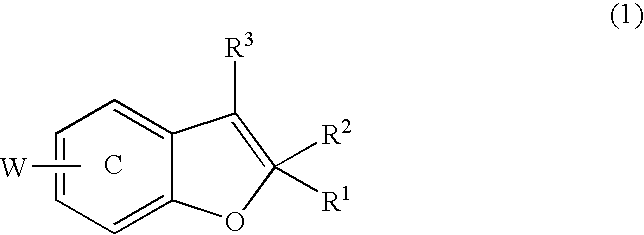Benzofuran derivatives, their production and use
a technology of benzofuran and derivatives, applied in the field of new drugs, can solve the problems of suppressing the progress of neurodegeneration, l-dopa is gradually lost, suppressing the progress of neurodegenerative diseases, etc., and achieves excellent pharmaceutical activities, low toxicity, and inhibitory activity.
- Summary
- Abstract
- Description
- Claims
- Application Information
AI Technical Summary
Benefits of technology
Problems solved by technology
Method used
Image
Examples
reference example 2a
Ethyl 2-methyl-3-(4-methylphenyl)-2-propenoate
[0605] To a suspension of sodium hydride (a 60% dispersion in liquid paraffin, 15.0 g, 375 mmol) in N,N-dimethylformamide (160 ml) was added at 0° C. a solution of triethyl 2-phosphonopropionate (87.7 g, 368 mmol) in N,N-dimethylformamide (10 ml) and the resulting mixture was stirred at the same temperature for 1 hour. To the reaction solution was added 4-methylbenzaldehyde (43.3 g, 361 mmol) and the resulting mixture was stirred at room temperature for 1 hour. Water was added into the reaction solution and the product was extracted twice with ethyl acetate. The combined extracts were washed with water, dried on magnesium sulfate, and then concentrated under reduced pressure to obtain 66.7 g (91% yield) of the oily title compound.
[0606]1H-NMR (CDCl3) δ: 1.34 (3H, t, J=7.0 Hz), 2.12 (3H, d, J=1.4 Hz), 2.37 (3H, s), 4.26 (2H, q, J=7.0 Hz), 7.19 (2H, d, J=8.4 Hz), 7.31 (2H, d, J=8.4 Hz), 7.66 (1H, s).
reference example 3a
Ethyl 3-(4-fluorophenyl)-2-methyl-2-propenoate
[0607] By using 4-fluorobenzaldehyde, the title compound was synthesized according to Reference Example 1a. Yield: 97%. An oily substance.
[0608]1H-NMR (CDCl3) δ: 1.35 (3H, t, J=7.0 Hz), 2.10 (3H, d, J=1.2 Hz), 4.28 (2H, q, J=7.0 Hz), 7.08 (2H, t, J=8.8 Hz), 7.32-7.43 (2H, m), 7.65 (1H, s).
reference example 4a
Ethyl (E)-3-(4-isopropylphenyl)-2-propenoate
[0609] To a suspension of sodium hydride (a 60% dispersion in liquid paraffin, 10.4 g, 260 mmol) in N,N-dimethylformamide (200 ml) was added at 0° C. triethyl 2-phosphonoacetate (58.2 g, 236 mmol) and the resulting mixture was stirred at the same temperature for 10 minutes. To the reaction solution was added 4-isopropylbenzaldehyde (35.0 g, 260 mmol) and the resulting mixture was stirred at room temperature for 30 minutes. Water was added into the reaction solution and the product was extracted twice with ethyl acetate. The combined extracts were washed with water, dried on magnesium sulfate, and then concentrated under reduced pressure to obtain 47.5 g (92% yield) of the oily title compound.
[0610]1H-NMR (CDCl3) δ: 1.25 (6H, d, J=7.0 Hz), 1.33 (3H, t, J=7.0 Hz), 2.92 (1H, septet, J=7.0 Hz), 4.26 (2H, q, J=7.0 Hz), 6.40 (1H, d, J=15.8 Hz), 7.24 (2H, d, J=8.2 Hz), 7.46 (2H, d, J=8.2 Hz), 7.67 (1H, d, J=15.8 Hz).
PUM
| Property | Measurement | Unit |
|---|---|---|
| reaction time | aaaaa | aaaaa |
| reaction time | aaaaa | aaaaa |
| temperature | aaaaa | aaaaa |
Abstract
Description
Claims
Application Information
 Login to View More
Login to View More - R&D
- Intellectual Property
- Life Sciences
- Materials
- Tech Scout
- Unparalleled Data Quality
- Higher Quality Content
- 60% Fewer Hallucinations
Browse by: Latest US Patents, China's latest patents, Technical Efficacy Thesaurus, Application Domain, Technology Topic, Popular Technical Reports.
© 2025 PatSnap. All rights reserved.Legal|Privacy policy|Modern Slavery Act Transparency Statement|Sitemap|About US| Contact US: help@patsnap.com



